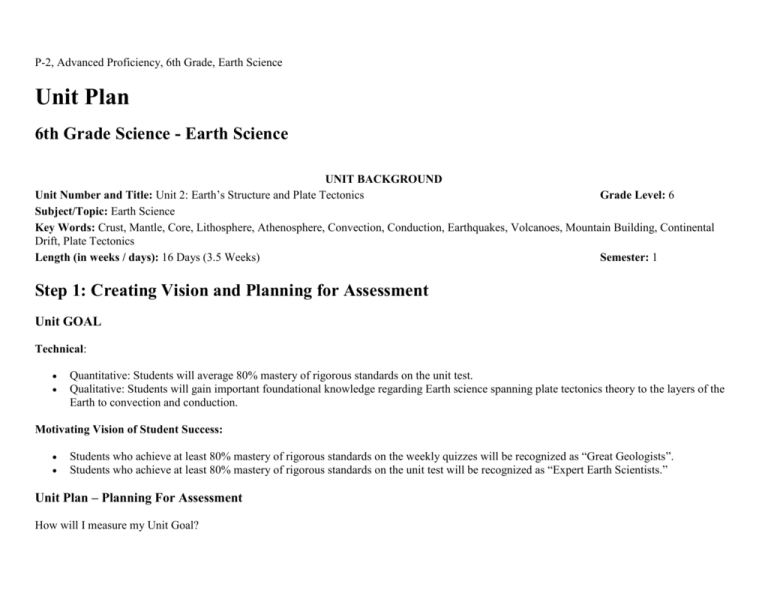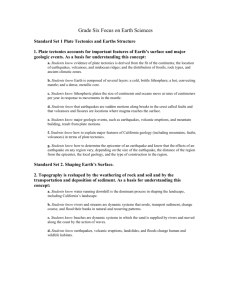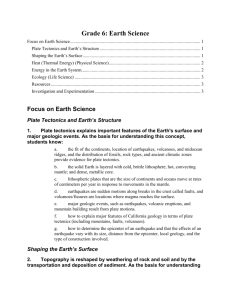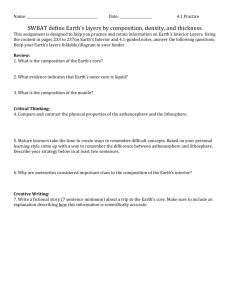Unit Plan - Teaching As Leadership
advertisement

P-2, Advanced Proficiency, 6th Grade, Earth Science Unit Plan 6th Grade Science - Earth Science UNIT BACKGROUND Unit Number and Title: Unit 2: Earth’s Structure and Plate Tectonics Grade Level: 6 Subject/Topic: Earth Science Key Words: Crust, Mantle, Core, Lithosphere, Athenosphere, Convection, Conduction, Earthquakes, Volcanoes, Mountain Building, Continental Drift, Plate Tectonics Length (in weeks / days): 16 Days (3.5 Weeks) Semester: 1 Step 1: Creating Vision and Planning for Assessment Unit GOAL Technical: Quantitative: Students will average 80% mastery of rigorous standards on the unit test. Qualitative: Students will gain important foundational knowledge regarding Earth science spanning plate tectonics theory to the layers of the Earth to convection and conduction. Motivating Vision of Student Success: Students who achieve at least 80% mastery of rigorous standards on the weekly quizzes will be recognized as “Great Geologists”. Students who achieve at least 80% mastery of rigorous standards on the unit test will be recognized as “Expert Earth Scientists.” Unit Plan – Planning For Assessment How will I measure my Unit Goal? Mastery of objectives on the Unit Test How will I measure progress toward the Unit Goal? Pretest, Quizzes, Daily “Do Now”, Independent Practice, Labs, Performance Tasks Unit Plan - What’s The Big Idea? Plate Tectonics and Earth’s Structure Energy in the Earth’s System Heat Investigation and Experimentation Unpacking Your Standards Unit Plan – Standards for this Unit 1a - Students know evidence of plate tectonics is derived from the fit of the continents; the location of earthquakes, volcanoes, and midocean ridges; and the distribution of fossils, rock types, and ancient climatic zones. 1c - Students know lithospheric plates the size of continents and oceans move at rates of centimeters per year in response to movements in the mantle. 1e - Students know major geologic events, such as earthquakes, volcanic eruptions, and mountain building, result from plate motions. 1b - Students know Earth is composed of several layers: a cold, brittle lithosphere; a hot, convecting mantle; and a dense, metallic core. 3c - Students know heat flows in solids by conduction (which involves no flow of matter) and in fluids by conduction and by convection (which involves flow of matter). 4c - Students know heat from Earth's interior reaches the surface primarily through convection. Unit Plan – Enduring Understandings Unit Plan – Essential Questions To meet the standards, students will need to To understand, students will need to Unit Plan – Tasks What are the tasks implied by the verbs in the standards? understand that: Heat can be transferred through conduction and convection. The Earth is divided into layers: the crust, the mantle, and the core. The lithosphere includes the crust and the upper layer of the mantle. The theory of plate tectonics explains plate movements and how the surface of the Earth changes. consider such questions as: What would happen to the Earth if the core ran out of heat? What are similarities and differences between conduction and convection? What relationships exist between the layers of the Earth? How does heat from the Earth’s interior reach the surface? Why have major geological events in history occurred? What is plate tectonics theory and what evidence do we have that it is accurate? Identify the layers of the Earth on a diagram and explain the relationship among the layers. Compare and contrast conduction and convection. Explain how heat from Earth’s interior reaches the surface primarily through convection. Explain how lithospheric plates the size of continents and oceans, move at rates of centimeters per year in response to movements in the mantle. Explain how major geologic events, such as earthquakes, volcanic eruptions, and mountain building, result from plate motions. Unit Plan – Achievement Targets To understand, students will need to have knowledge of: Concepts: Layers of the Earth The layers of the Earth: crust, mantle, and core The lithosphere and asthenosphere Conduction and Convection To understand, students will need to be able to: Layers of the Earth Identify the layers of the Earth on a diagram and explain the relationship among the layers. (1b) Conduction and Convection Compare and contrast conduction and convection. (3c) Cold liquids and gases are more dense that warm liquids and gases How Heat from the Earth’s Interior Reaches the Surface Circular motion of liquids and gases in a convection current results from differences in density Explain how heat from Earth’s interior reaches the surface primarily through convection. (4c) How Heat from the Earth’s Interior Reaches the Surface Heat from the Earth’s interior reaches the surface primarily through convection. Plate Movement Plate Movement Explain how lithospheric plates the size of continents and oceans, move at rates of centimeters per year in response to movements in the mantle. (1c) Plates are constantly in motion. Geologic Events Geologic Events Geologic events such as earthquakes, volcanoes, and mountain building are caused by plate motions. Explain how major geologic events, such as earthquakes, volcanic eruptions, and mountain building, result from plate motions. (1e) Plate Tectonics Theory Plate Tectonics Theory The fit of the continents, location of earthquakes, volcanoes, and midocean ridges, and the distribution of fossils, rock types, and ancient climatic zones provide evidence for the theory of plate tectonics. Vocabulary: Layers of the Earth Crust Mantle Core Lithosphere Asthenosphere Conduction and Convection Convection – liquids and gases Conduction – solids Flow of matter Thermal energy Determine how the fit of the continents, the location of earthquakes, volcanoes, and midocean ridges, and the distribution of fossils, rock types, and ancient climatic zones provide evidence of plate tectonics. (1a) Convection current How Heat from the Earth’s Interior Reaches the Surface Plates Plate Movement Transform boundaries Divergent boundaries Convergent boundaries Geologic Events Faults Earthquakes Volcanoes Volcanic eruption Mountain Mountain building Plate Tectonics Continent Continental drift Fossils Rock types Ancient climatic zones Steps 2 and 3: Misunderstandings & Lesson Objectives Standard Daily Lesson Objective(s) # of Potential Misunderstandings days, 1 Lesson Plan Notes day = xx min. 1b - Students know Earth is composed of several layers: a cold, brittle lithosphere; a hot, convecting mantle; and a dense, metallic core. 3c - Students know heat flows in solids by conduction and in fluids by conduction and by convection. SWBAT identify the location of the .5 layers of the Earth. SWBAT identify characteristics of the layers. .5 SWBAT explain the relationship among the layers. 1 SWBAT describe conduction. SWBAT describe convection. SWBAT explain what causes convection currents. SWBAT illustrate a convection current. SWBAT compare and contrast conduction and convection. Demonstration: How is The interior of the Earth is cold. an apple like Earth? (pg. 12) .25 .25 .25 Cold objects are more dense than hot objects. Demonstration: How can heat cause motion in a liquid? (pg. 15) Convection currents blend the layers within the Earth. Performance Task: Journey to the Center of the Earth Travel Brochure .25 .5 4c - Students know heat from Earth's interior reaches the surface primarily through convection. 1c - Students know lithospheric plates the size of continents and oceans move at rates of centimeters per year in response to movements in the mantle. 1e - Students know major geologic events, such as earthquakes, volcanic eruptions, and mountain building, result from plate motions. SWBAT explain how heat from Earth’s interior reaches the surface primarily through convection. SWBAT explain that convection currents cause shifting of the lithospheric plates. SWBAT state the rate at which continents and oceans move each year. .5 .5 .5 SWBAT describe the characteristics 1 and types of earthquakes. SWBAT describe the characteristics 1 and types of volcanic eruptions. SWBAT describe the process and Continents do not move. Continents move because of earthquakes. Lab: Hot Plates (pg. 38) Earthquakes, volcanic eruptions Lab: Stress in the Crust and mountain building happen (pg. 44-45) superficially and do not require any other layers of the Earth. Jigsaw: Types of 1a - Students know evidence of plate tectonics is derived from the fit of the continents; the location of earthquakes, volcanoes, and midocean ridges; and the distribution of fossils, rock types, and ancient climatic zones. types of mountain building. SWBAT explain how earthquakes, volcanic eruptions, and mountain building are the result of plate motions. SWBAT describe the organization of the continents. SWBAT identify the location of earthquakes, volcanoes, and midocean ridges. SWBAT identify the distribution of fossils, rock types, and ancient climatic zones. SWBAT explain how the fit of the continents, location of earthquakes, volcanoes, and midocean ridges, and the distribution of fossils, rock types, and ancient climatic zones provide evidence for plate tectonics theory. SWBAT describe plate tectonics theory. 1 Plates collide like bumper cars. 1 volcanoes Gallery: Compare pictures of mountains with different types of faults. (pg. 46-47) Lab: Modeling Movement Along Faults (pg. 52-53) Lab: How well do the continents fit together? (pg. 32) Lab: Mapping Earthquakes and Volcanoes (pg. 82) 1 1 1 1 1 Unit Review and Assessment 2 Total 16 Plate tectonics theory is a fact. Lab: How are seeds moved from place to place? (pg. 21) Lab: Stations that lead students to put together the theory of plate tectonics Performance Task: Presentation on evidence for plate tectonics theory 1 Day of Review Unit Test (60 minutes) Step 4: Sequencing & Scaffolding Objectives on Calendar September Monday (60 min) Tuesday (45 min) Wednesday (60 min) Thursday (60 min) Friday (60 min) 4 5 Begin UNIT 2: PLATE TECTONICS AND EARTH’S STRUCTURE Pretest for Unit 2 (10 min) 3 LABOR DAY 10 SWBAT explain that convection currents cause shifting of the lithospheric plates. SWBAT describe convection. SWBAT describe conduction. SWBAT explain what SWBAT identify the causes convection location of the layers of currents. the Earth. SWBAT compare and SWBAT identify contrast conduction and characteristics of the convection. layers. Demonstration: How can Demonstration: How is heat cause motion in a an apple like Earth? (pg. liquid? (pg. 15) 12) 11 12 6 SWBAT illustrate convection currents. SWBAT explain how heat from Earth’s interior reaches the surface primarily through convection. Jigsaw: Types of volcanoes SWBAT explain the relationship among the layers. Quiz #1 (1b, 3c, 4c) Performance Task: Journey Performance Task: Journey to the Center of to the Center of the Earth the Earth Travel Brochure Travel Brochure 13 SWBAT describe the SWBAT describe the SWBAT describe the process and types of characteristics and types characteristics and types mountain building. of earthquakes. of volcanic eruptions. Lab: Stress in the Crust SWBAT state the rate (pg. 44-45) 7 Gallery: Compare pictures of mountains with different types of faults. (pg. 46-47) 14 SWBAT explain how earthquakes, volcanic eruptions, and mountain building are the result of plate motions. at which continents and oceans move each year. Quiz #2 (1c, 1e) Lab: Modeling Movement Along Faults (pg. 52-53) Lab: Hot Plates (pg. 38) 17 SWBAT describe the organization of the continents. 18 19 SWBAT identify the location of earthquakes, volcanoes, and midocean ridges. SWBAT identify the distribution of fossils, rock types, and ancient climatic zones. Lab: How well do the Lab: Mapping continents fit together? Earthquakes and (pg. 32) Volcanoes (pg. 82) Lab: How are seeds moved from place to place? (pg. 21) 26 24 Review 25 Unit 2 Test Begin UNIT 3: SHAPING EARTH’S SURFACE 20 21 SWBAT explain how the fit of the SWBAT describe plate continents, location of earthquakes, tectonics theory. volcanoes, and midocean ridges, and the distribution of fossils, rock types, and Quiz #3 (1a) ancient climatic zones provide evidence for plate tectonics theory. Performance Task: Presentation on evidence Lab: Stations that lead students to put for plate tectonics theory together the theory of plate tectonics








